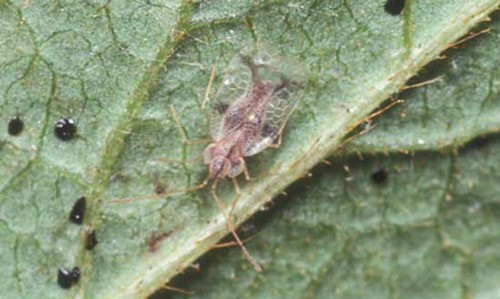
by Sheila Dunning | Mar 20, 2017
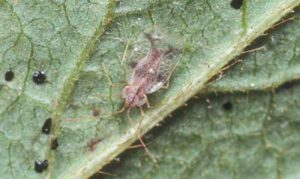 Now is the time to prevent your azaleas from being attacked by lace bugs. The azalea lace bug, Stephanitis pyrioides, overwinters as eggs on the underside of infested leaves. Eggs hatch in late March and early April. The insect then passes through five nymphal instars before becoming an adult. It takes approximately one month for the insect to complete development from egg to adult and there are at least four generations per year. Valuable plants that are susceptible to lace bug damage should be inspected in the early spring for the presence of overwintering lace bug adults, eggs and newly hatched nymphs. Inspect these plants every two weeks during the growing season for developing lace bug infestations.
Now is the time to prevent your azaleas from being attacked by lace bugs. The azalea lace bug, Stephanitis pyrioides, overwinters as eggs on the underside of infested leaves. Eggs hatch in late March and early April. The insect then passes through five nymphal instars before becoming an adult. It takes approximately one month for the insect to complete development from egg to adult and there are at least four generations per year. Valuable plants that are susceptible to lace bug damage should be inspected in the early spring for the presence of overwintering lace bug adults, eggs and newly hatched nymphs. Inspect these plants every two weeks during the growing season for developing lace bug infestations.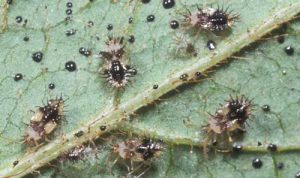
Both adults and nymphs have piercing-sucking mouthparts and remove sap as they feed from the underside of the leaf. Lace bug damage to the foliage detracts greatly from the plants’ beauty, reduces the plants’ ability to produce food, decreases plant vigor and causes the plant to be more susceptible to damage by other insects, diseases or unfavorable weather conditions. The azalea can become almost silver or bleached in appearance from the feeding lace bug damage.
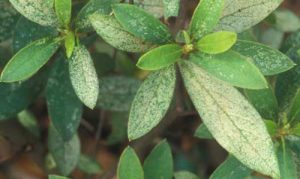 However, lace bugs often go undetected until the infested plants show severe damage sometime into the summer. By then several generations of lace bugs have been weakening the plant. Inspecting early in the spring and simply washing them off the underside of the leaves can help to avoid damage later and the need for pesticides.
However, lace bugs often go undetected until the infested plants show severe damage sometime into the summer. By then several generations of lace bugs have been weakening the plant. Inspecting early in the spring and simply washing them off the underside of the leaves can help to avoid damage later and the need for pesticides.
Adult lace bugs are flattened and rectangular in shape measuring 1/8 to 1/4 inch long. The area behind the head and the wing covers form a broadened, lace-like body covering. The wings are light amber to transparent in color. Lace bugs leave behind spiny black spots of frass (excrement).
Lace bug nymphs are flat and oval in shape with spines projecting from their bodies in all directions. A lace bug nymph goes through five growth stages (instars) before becoming an adult. At each stage the nymph sheds its skin (molts) and these old skins often remain attached to the lower surface of infested leaves.
Azalea lace bug eggs are football-shaped and are transparent to cream-colored. Lace bug eggs are found on the lower leaf surface, usually alongside or inserted into a leaf vein. Adult females secrete a varnish-like substance over the eggs that hardens into a scab-like protective covering.
For more information go to: http://entomology.ifas.ufl.edu/creatures/orn/shrubs/azalea_lace_bug.htm
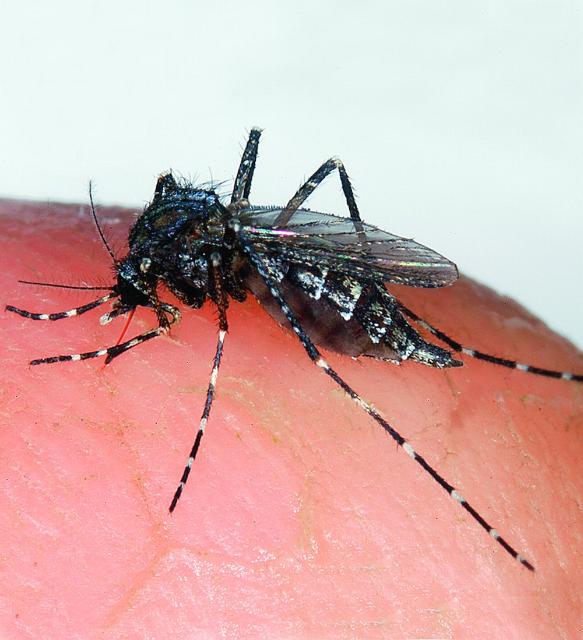
by Les Harrison | Mar 11, 2017
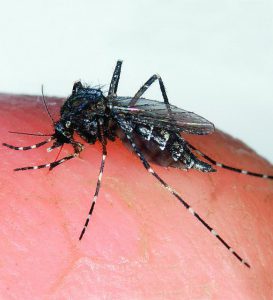 It is an often made wish of summer that the cold weather of winter will kill all the mosquitoes, gnats and no-see-ums. This climactic fete would spare people, pets and livestock the irritation of encountering these low flying pest and their predatory behavior.
It is an often made wish of summer that the cold weather of winter will kill all the mosquitoes, gnats and no-see-ums. This climactic fete would spare people, pets and livestock the irritation of encountering these low flying pest and their predatory behavior.
Unfortunately, the thermometer would have to drop to levels approaching the surface temperature of the planet Neptune to eliminate these winged annoyances.
There are individual steps which will help minimize the potential for exposure to exotic diseases.
Check surroundings for standing water, especially in secluded spots or small quantities. The home landscape and patio garden can produce hundreds, if not thousands, of hungry mosquitos during the summer if standing water is left for long.
Trays and dishes under flower pots commonly collect water which is usually left to evaporate or be absorbed by the plant over time. To mama mosquito this shallow and protected source is an ideal location to deposit eggs for the next generation of voracious airborne insects.
Plants with natural depressions or “cups” can accumulate enough irrigation and rain water to establish an effective mosquito nursery. Even though it may evaporate, these tiny pools will last long enough to hatch many mosquito larvae into potential disease vectors.
Back porch bromeliads can easily deliver this undesirable outcome. So too can mature live oak trees which commonly have hollow spaces between large branches.
Even a wheelbarrow left to the elements can serve as a portable pond to maternity minded mosquitos. Dumping the water on a frequent basis is the easiest method, but there are also larvae-cides which are effective in difficult to dump reservoirs.
Protective clothing when outdoors is useful to reduce exposed skin which mosquitos view as an excellent dining site. Heavier fabrics and loose-fitting designs provide the best protection while maintaining maximum comfort for the wearer.
Minimizing exposure at dusk and dawn, when native mosquitos are most active, will reduce the probability of serving as an unsuspecting blood meal for a swarm or lone hunter. Unfortunately, some of the exotic mosquitos are prowling 24 hours a day and are pleased to attack at any opportunity.
As the weather warms, be ready for mosquito season. This past winter only whetted their appetite.
by Sheila Dunning | Dec 7, 2016
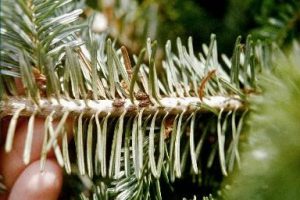 Christmas is coming. So much to do. Picking out the perfect, fresh-cut tree is one of the important
Christmas is coming. So much to do. Picking out the perfect, fresh-cut tree is one of the important 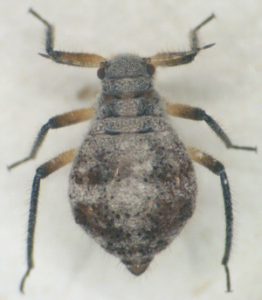 tasks. Every family member has their specific requirement. “It has to be a certain species.” It has to be a specific height and shape.” And, of course, “It has to smell great.” So, a decision is made. The perfect tree is toted home, put up and beautifully decorated. A week later, mom shrieks, “There’s ticks all over the living room!” Don’t panic. Upon inspection, you will discover that the bugs coming from your “perfect” Christmas tree are Cinara aphids.
tasks. Every family member has their specific requirement. “It has to be a certain species.” It has to be a specific height and shape.” And, of course, “It has to smell great.” So, a decision is made. The perfect tree is toted home, put up and beautifully decorated. A week later, mom shrieks, “There’s ticks all over the living room!” Don’t panic. Upon inspection, you will discover that the bugs coming from your “perfect” Christmas tree are Cinara aphids.
Cinara are a group of several species of large brown or black aphids that feed on conifers including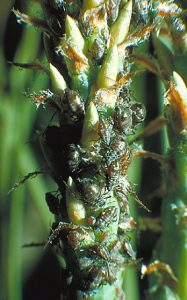 all pines, spruces and firs. When the Christmas trees are cut at the farm and bundled for shipment, the aphids get trapped. With warmer temperatures indoors, the aphids become active. Infestations may also arise from overwintering eggs that hatch. As the tree dries out, the aphids crawl from the tree into the rest of the house.
all pines, spruces and firs. When the Christmas trees are cut at the farm and bundled for shipment, the aphids get trapped. With warmer temperatures indoors, the aphids become active. Infestations may also arise from overwintering eggs that hatch. As the tree dries out, the aphids crawl from the tree into the rest of the house.
No worries. Cinara aphids only feed on conifers, so they pose no threat to other plants. They are not a danger to people or pets either. But don’t get rid of them by smashing them. You may be left with a nasty purple stain to have to clean up. Instead, pull out the vacuum and suck them up.
So, if you are one of those people still shopping for the “perfect” tree, add a preemptive strike to your decorating procedure. Unbundle and shake, shake, shake that tree outside before bringing it in. Then the only shrieking going on will be when mom opens the fabulous present you gave her.
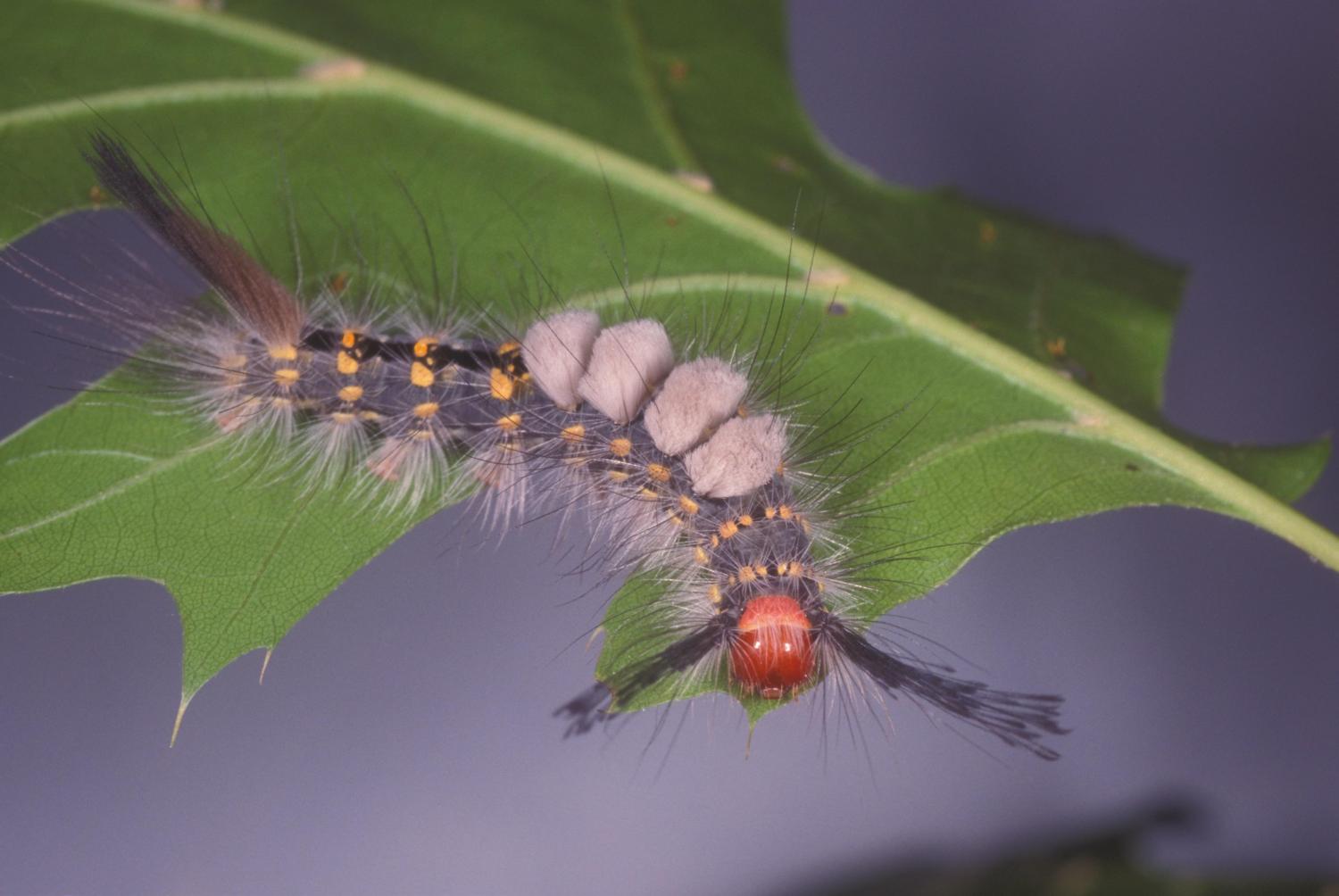
by Larry Williams | Oct 26, 2016
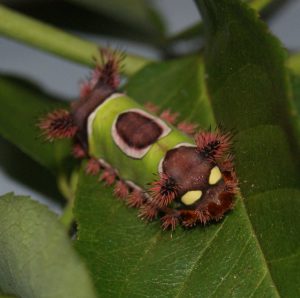
Saddleback Caterpillar – Image Credit Matthew Orwat
The reality of what happens deep down in the darkness of a fire ant mound hidden to human eyes or in the tunnels of a mole cricket where only creepy crawly things dare to enter may be too scary to believe.
University of Florida Institute of Food and Agricultural Sciences along with USDA introduced a tiny South American fly to the U.S. to help control the pesky imported fire ant. Literally, these introduced phorid flies cause the imported fire ants’ heads to fall off. They then use the decapitated heads to reproduce. The flies hover above the ants, dive in, latch on to the ant’s body and inject their eggs. The egg hatches, and a maggot wiggles its way into the ant’s head, where it grows for two to three weeks before secreting a chemical that dissolves the membranes holding the ant’s body together. In a few hours the ant’s head falls off. The maggot eats everything in it and then uses it as a pupae case. Gruesome, isn’t it?
Assassin bugs are frequently seen slowly crawling on shrubs in our landscapes. Most are brown to black but many are brightly colored. A common species is reddish-orange in the nymph stage. Assassin bugs feed on many harmful insects. Caterpillars are their favorite food.
They digest their prey before eating it. They do this by piercing their victim with their sharp beak, injecting digestive enzymes. This causes chaos on the unfortunate insect’s nervous system and liquefies the internal organs. The liquefied contents are then consumed, leaving only the shell of its kill. How tragic.
The larra wasp, an introduced predatory insect by University of Florida entomologists, enters a mole cricket tunnel. The female wasp will pounce on the mole cricket, wrestle with it and sting it on its soft underside. This immobilizes the mole cricket long enough to allow the wasp to deposit a single egg on its underside. The mole cricket recovers and burrows back into the ground. The wasp larva eventually hatches and slowly eats the mole cricket alive. Poor mole cricket.
We mere mortals should be aware of these horrifying happenings occurring in our own backyards. And we should be frightened by those people who attempt to kill every six-legged critter in sight because they have wrongly identified them as bad. In reality, less than one percent of all insects that exist are damaging to our plants. Most are of no consequence to our lawns, landscapes or gardens. And many are beneficial.
These beneficial insects are helping us gardeners battle the bad bugs during Halloween and year round.
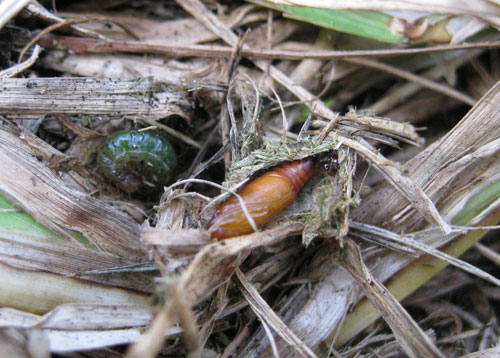
by Matt Lollar | Sep 29, 2016
Tropical sod webworms (Herpetogramma phaeopteralis) have recently been encountered in a number of yards in the Panhandle. The worms usually feed in large groups and unfortunately, the first, and basically the only, sign of damage is often a large area of shorter grass due to their feeding. The arrival time of sod webworms is also unfortunate because they are part of a group of caterpillars that successively attack turf including fall armyworm (Spodoptera frugiperda), striped grass loopers (Mocisspp.), and the fiery skipper (Hylephila phyleus).
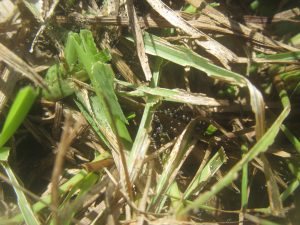
Sod webworm feeding damage in the turf thatch layer. Photo Credit: University of Florida/IFAS Extension.
Description
Larvae
Caterpillars are light yellow to orange with brown spots on each body segment and they have a dark, orange-brown head. They will grow to a full length of slight less than 1/2 inch.
Pupae
The reddish brown pupae are about about 1/4 inch long. The pupae are typically found in the upper thatch layer.
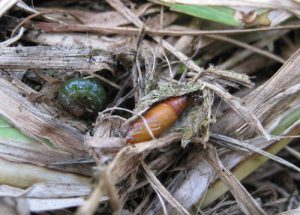
Pupa found in cocoon in St. Augustinegrass thatch. Photo Credit: Steven Arthurs, University of Florida/IFAS
Adults
The moths brown with splotchy wings and are about 3/4 inch wide.
Control
Sod webworms are difficult to control because of their spontaneity. However, in the lawn they hide in the thatch during the heat of the day. Over watering and fertilization can increase the amount of thatch. It is important to follow UF/IFAS guidelines for home lawn management.
The first line of defence is healthy turf. Proper fertilization, irrigation, and mowing height can decrease susceptibility of turfgrass against sod webworm. Over-fertilization is a common cause of caterpillar outbreaks in lawns. Cultural practices such as thatch removal by vertical mowing can help eliminate populations. Eggs are laid on grass blades and removal of grass clippings might also reduce populations.
Numerous chemical control options are available, but softer chemicals such as insecticides containing the bacteria Bacillus thuringiensis are recommended as a first line of defense. Insecticides should be applied in the morning or evening during feeding time. For additional control strategies and basic information please visit the UF/IFAS Sod Webworm Publication.

by Matt Lollar | Sep 8, 2016
Plants can become distorted for a wide variety of reasons. Sometimes nutrient deficiencies or toxicities can cause plants to become distorted. Sometimes excessive amounts of water or sunlight can cause plants to become distorted. And sometimes insect feeding damage can be the culprit.
Insects can cause plant mutations by feeding alone or by vectoring disease from one plant to another. The most recent and most detrimental example of insects vectoring disease is the Asian Citrus Psyllid, which has distributed Huanglongbing, also known as citrus greening, to most of the citrus acreage in Florida and across the United States. Fortunately, the panhandle is currently free from this detrimental disorder. However, we still have a plethora of insects that distort plants by one way or another. One group of plant altering insects are commonly known as planthoppers.
Planthopper adults range in size between 1/8 to 1/4 inches long. They are slender and frequently have an angular, pointed head. Coloration depends on species, but generally planthoppers are of green, brown, or white. Immatures look similar to the adults except they are smaller and don’t have wings. Immatures typically feed on the underside of leaves, where the humidity is higher and they are more protected from predators.
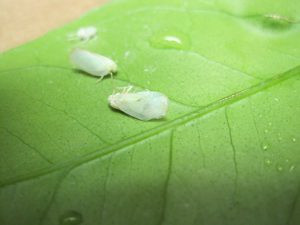
Three growth stages of planthoppers. Photo Credit: UF/IFAS Extension
Planthoppers feed on plant leaves and shoots by sucking out the contents. The damage that ensues from feeding depends on the host plant and the hopper species. A few species of hoppers transmit pathogens that can alter plant growth. Usually, adult hoppers are pests only when found in high numbers.
Feeding damage from some species causes small white spots (stippling) to appear on the upper leaf surface, usually beginning near the leaf midrib. Stippled areas eventually merge together into larger whitish blotches. In some plants, feeding damage causes a drying and yellowing (or browning) of leaf tips and some planthopper species cause curling or stunting of newly formed leaves. Oftentimes, white, papery skin castings will remain from the molting process on the undersides of leaves.
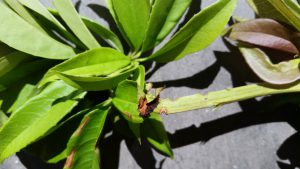
Planthopper feeding damage on sweet olive. Photo Credit: UF/IFAS Extension
Planthoppers are rarely present in large enough numbers to cause significant plant damage. Fortunately, planthoppers have many natural enemies including lady beetles, lacewings, damsel bugs, and spiders. Sticky traps are recommended to help monitor planthopper populations. Planthoppers are usually attracted to yellow sticky traps that can be placed among the plant leaves. Small populations can be managed using these traps. If greater populations are present, then insecticidal soap can control young planthoppers. Make sure to spray both the top and underside of the leaves.
Planthoppers are minor pests in the landscape, but they can cause alarming mutations in plant material. Contact your local Extension Office for help with diagnosis and treatment options.

 Now is the time to prevent your azaleas from being attacked by lace bugs. The azalea lace bug, Stephanitis pyrioides, overwinters as eggs on the underside of infested leaves. Eggs hatch in late March and early April. The insect then passes through five nymphal instars before becoming an adult. It takes approximately one month for the insect to complete development from egg to adult and there are at least four generations per year. Valuable plants that are susceptible to lace bug damage should be inspected in the early spring for the presence of overwintering lace bug adults, eggs and newly hatched nymphs. Inspect these plants every two weeks during the growing season for developing lace bug infestations.
Now is the time to prevent your azaleas from being attacked by lace bugs. The azalea lace bug, Stephanitis pyrioides, overwinters as eggs on the underside of infested leaves. Eggs hatch in late March and early April. The insect then passes through five nymphal instars before becoming an adult. It takes approximately one month for the insect to complete development from egg to adult and there are at least four generations per year. Valuable plants that are susceptible to lace bug damage should be inspected in the early spring for the presence of overwintering lace bug adults, eggs and newly hatched nymphs. Inspect these plants every two weeks during the growing season for developing lace bug infestations.
 However, lace bugs often go undetected until the infested plants show severe damage sometime into the summer. By then several generations of lace bugs have been weakening the plant. Inspecting early in the spring and simply washing them off the underside of the leaves can help to avoid damage later and the need for pesticides.
However, lace bugs often go undetected until the infested plants show severe damage sometime into the summer. By then several generations of lace bugs have been weakening the plant. Inspecting early in the spring and simply washing them off the underside of the leaves can help to avoid damage later and the need for pesticides.












